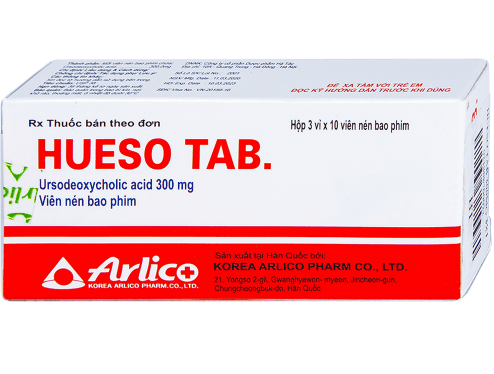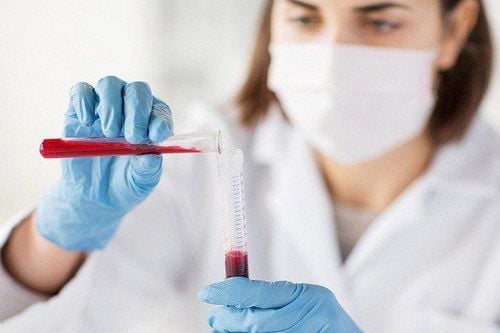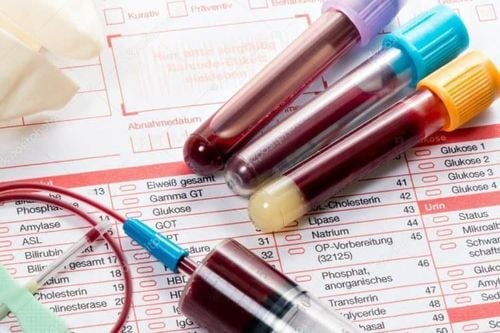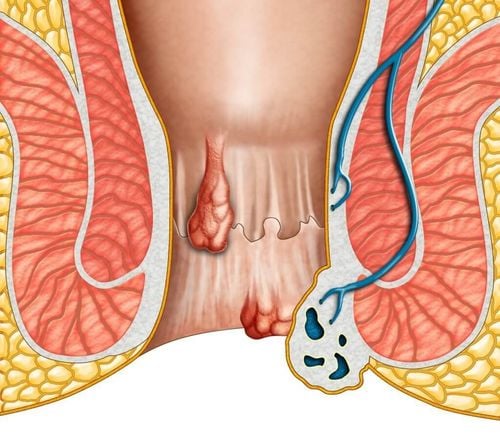This is an automatically translated article.
The article was professionally consulted by BSCK I Le Thi Nha Hien - Department of Medical Examination & Internal Medicine, Vinmec Nha Trang International General Hospital.Blood test is one of the routine tests ordered by doctors when examining and treating patients. It provides important indicators to help diagnose disease, monitor disease progression and evaluate treatment progress. The following article will provide the meaning of the indicators in a blood test and a few notes before the test.
1. What is a blood test for?
Blood test is a fairly simple test and usually includes the following types of tests:
Complete blood count test: Determines indicators of red blood cells, white blood cells, and platelets, thereby helping to diagnose diseases early pathology of the hematopoietic system such as anemia, marrow failure, blood cancer or early warning of other inflammatory diseases Blood sugar test: Helps determine blood sugar levels for diagnosis and treatment monitoring in diabetes Street . Blood lipid test : Helps determine cholesterol and triglyceride levels in the blood. Liver enzyme tests: Includes ALT (also known as SGPT) and AST (also known as SGOT) enzymes that are released when there is damage to liver cells. ALT is found mainly in the liver, and AST is not only in the liver but also in cardiac muscle, skeletal muscle, pancreas, kidney, brain, etc. Therefore, ALT concentration is more specific for liver damage than AST. Normal values for AST are 9 to 48 and ALT is 5 to 49.
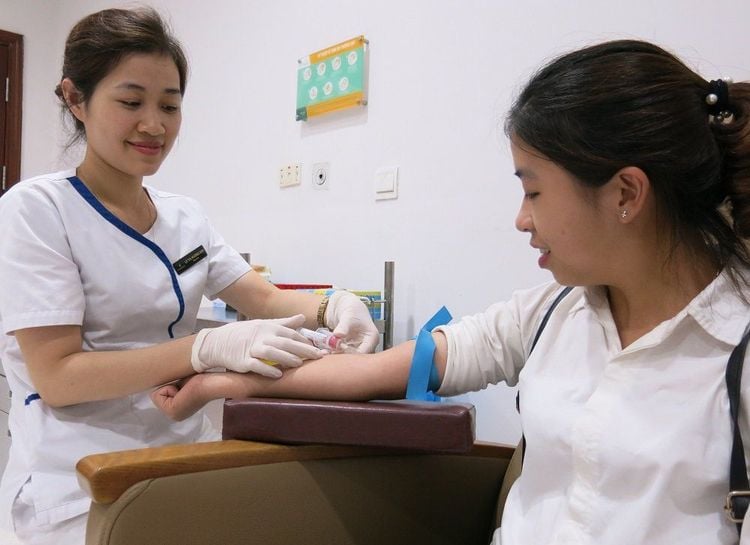
2. Meaning of indicators in blood count test
WBC (White Blood Cell) - White blood cell count in a volume of blood
Normal value ranges from 4,300 to 10,800 cells/mm3 Increased in cases of bacterial infection, parasitic infection, acute lymphoblastic leukemia, disease acute myeloid leukemia, leukaemia, use of certain drugs such as corticosteroids. Decreased in aplastic anemia, viral infections (HIV, hepatitis virus), vitamin B12 or folate deficiency, taking some drugs like phenothiazine, chloramphenicol,..
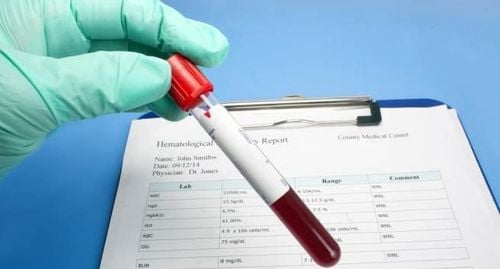
LYM (Lymphocyte - Lymphocyte)
Lymphocytes are cells with immunity, including T and B lymphocytes. Lymphocyte increase in infection, lymphocytic leukemia, adrenal insufficiency,..Decrease in HIV/AIDS infection, tuberculosis, cancer, severe typhoid, malaria,... Usually 20 to 25% NEUT (Neutrophil) - neutrophils
Usually between 60 and 66%. Neutrophils have an important function of phagocytosis. They will attack and "eat" the bacteria as soon as these organisms enter the body, so are often increased in acute infections. Increased in acute infection, acute myocardial infarction,...Reduced in aplastic anemia, immunosuppressive drugs, heavy metal poisoning... MON (monocyte) - monocyte
Usually from 4-8%. Monocytes are monocytes, which then differentiate into macrophages. Macrophages protect the body by phagocytosis and have a stronger phagocytic ability than neutrophils. Increases due to viral infections, tuberculosis, cancer, lymphomas,... Decreased in cases of aplastic anemia, taking corticosteroids.
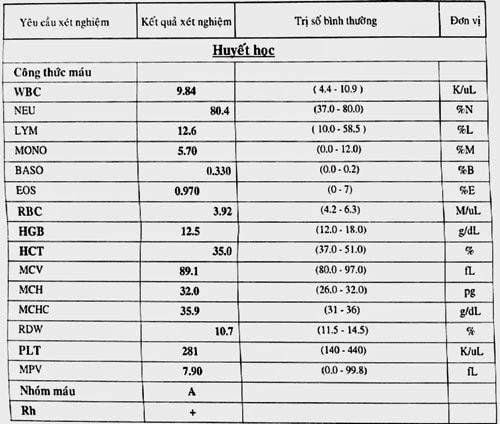
EOS (eosinophils) - eosinophils
Normal value 0.1-7% Eosinophils have weak phagocytosis. This white blood cell is increased in cases of parasitic infections or allergic diseases... decreased by corticosteroid use BASO (basophils) - basophils
Usually from 0.1-2.5% and plays an important role Important in allergic reactions Increased in chronic leukemia, splenectomy, polycythemia vera....decreased by bone marrow damage, stress, hypersensitivity.... RBC (Red Blood Cell) – Number of red blood cells in a volume of blood
Normal value ranges from 4.2 to 5.9 million cells/cm3 Increases in cardiovascular disease, polycythemia vera, dehydration Decreases in anemia, malaria, lupus erythematosus , marrow failure,... HBG (Hemoglobin) – The amount of hemoglobin in a volume of blood
Hemoglobin, also known as hemoglobin, is a complex protein molecule capable of transporting oxygen and giving red blood cells its red color. . The usual value in men is 13 to 18 g/dl; in women 12 to 16 g/dl Increases in dehydration, cardiovascular disease, burns Decreases in anemia, bleeding, hemolysis HCT (Hematocrit) – RBC to whole blood volume ratio
Normal value usually 45 to 52% for men and 37 to 48% for women. Increased in lung disease, cardiovascular disease, dehydration, erythrocytosis Decrease in blood loss, anemia, bleeding MCV (Mean corpuscular volume) – Mean volume of a red blood cell
Calculated by the formula: HCT divided by number red blood cell count and usually between 80 and 100 femtoliter (fl) Increased in macrocytic anemia due to vitamin B12 deficiency, folic acid deficiency, liver disease, erythrocytosis Decrease in iron deficiency anemia, thalassemia, anemia due to chronic diseases MCH (Mean Corpuscular Hemoglobin) – Mean amount of hemoglobin in a red blood cell
This value is calculated by dividing HBG by the number of red blood cells, usually between 27 and 32 picograms (pg) ) Increase in megaloblastic anemia, neonate Decrease in iron deficiency anemia MCHC (Mean Corpuscular Hemoglobin Concentration) – Mean concentration of hemoglobin in a volume of blood
Calculated by dividing HBG by HCT and normal between 32 and 36% MCHC increases and decreases in similar cases to MCH RDW (Red C ell Distribution Width) – Red blood cell size distribution
The higher this value is, the greater the change in the size of the red blood cells Normal value is between 11 and 15% PLT (Platelet Count) – The number of platelets in a body Blood clotting
Platelets play an important role in blood clotting. If the platelet count is too low, it will cause blood loss, and if the platelet count is too high, it will form a blood clot, causing a blood clot and possibly leading to a stroke or heart attack. Values are usually between 150,000 and 400,000. /cm3 Increased in trauma, after splenectomy, inflammation, bone marrow proliferative disorders Decreased in myelosuppression or myelosuppression, hypersplenism, metastatic cancer, chemotherapy, hemolytic disease in newborns,... PDW (Platelet Disruption Width) – Platelet Size Distribution
Usually in the range of 6 to 18 % Increased in lung cancer, sickle cell disease, sepsis, decreased in alcoholism MPV (Mean Platelet Volume) – Mean volume of platelets in a blood volume
Usually between 6.5 and 11fL Increases in cardiovascular disease, diabetes,...decreased in aplastic anemia, anemia erythrocytosis, acute leukemia,... Usually between 150 and 500 G/l (G/l = 109/l)
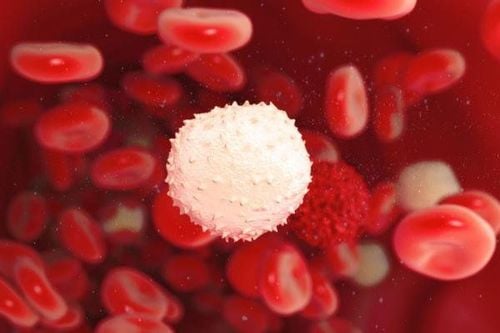
3. Things to note before a blood test
Do not take medicine before taking blood test: if you miss taking medicine before the test, please inform your doctor so that the doctor can give appropriate treatment because not all drugs affect the results. test.
Fasting: Some tests require fasting for 8 - 12 hours to give accurate results such as blood sugar test, blood fat test, liver disease test.... other tests such as HIV, hyperthyroidism,... the patient may not need to fast before the test
Do not use stimulants such as alcohol, coffee, tobacco...
Please dial HOTLINE for more information or register for an appointment HERE. Download MyVinmec app to make appointments faster and to manage your bookings easily.
Articles refer to the source: Quy Nhon Institute of Malaria, Parasites and Insects




